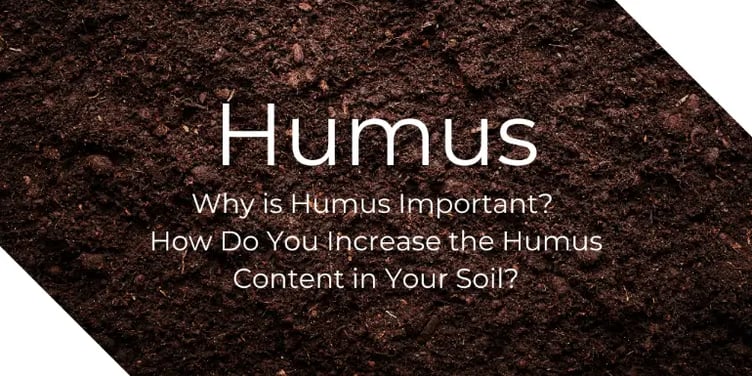
Did you know: Only 4-to-12 inches of humus-containing soil is available in Earth’s upper crust? These 12 inches are all that exist to provide nutrition to human life.
Humus is the final stage in the degradation of soil organic matter. It forms when plant (leaves and straw) and animal matter (mostly worms and insects) decompose in the soil. Humus improves soil fertility, water retention, CEC (cation exchange capacity), nutrient availability, and soil health. In fact, many soil scientists refer to humus as the pantry or storing house, for nutrients used by plants.
Humus content in agricultural soil ranges from 2-10%. Soil with at least 2-4% humus content is considered to be in good health. Despite its importance, soil humus content quantity is decreasing worldwide due to factors such as soil erosion, urbanization, and agricultural practices (such as tilling).
In this blog we discuss the following topics as it relates to humus:
- Why is humus important?
- How is humus formed?
- Which microbes affect humus formation?
- How do you improve humus content in your soil?
Why is humus important?
Humus serves five critical roles for plant health:
- Improving soil structure and reducing erosion - One of the key benefits of humus is its ability to improve soil structure. Humus acts as a binding agent, helping to create larger aggregates of soil particles. Plus, it reduces soil erosion by binding soil particles together.
- Storing and releasing nutrients - Humus also contains a range of nutrients, including nitrogen, phosphorus, and potassium, which are released slowly over time as it breaks down. The slow release of nutrients helps to ensure that plants have a steady supply of nutrients they need throughout the growing season.
- Storing and releasing water – Humus can act like a sponge, absorbing water and holding it in the soil for the plant to use during dry periods. When water is added to soil containing humus, some of the water is held on the surface of the humus particles, while the rest is held in the pore spaces between the particles. As the soil dries out, the water held in the humus slowly releases into the surrounding soil, providing a steady stream of moisture for plant roots.
- Sequestering carbon - Additionally, humus is an important source of carbon storage in soil, mitigating the effects of climate change by sequestering carbon from the atmosphere.
- Serving as a habitat for beneficial microbes – Humus is a habitat for a range of beneficial microbes which play a key role in soil health and nutrient cycling.
How is Humus Formed?
Humus is formed through the decomposition of plant and animal waste by soil microbes. When plants and animals are decomposed by soil microbes, the organic compounds they contain are broken down into simpler forms, such as sugars and amino acids. These compounds are then further broken down into more stable forms by soil microbes, eventually forming humus.
The formation of humus is a slow process that can take years or even centuries. Factors such as temperature, moisture, pH, and types of soil microbes present in the soil affect the rate at which organic matter is decomposed and humus is formed.
Which microbes affect humus formation?
The formation of humus involves a wide range of microorganisms. Some examples of species that are associated with humus formation include:
- Bacteria – Some species include Bacillus, Pseudomonas, Streptomyces, and Rhizobium.
- Fungi – Lignin and cellulose-degrading fungi are especially important. These include, but are not limited to Aspergillus, Penicillium, and Mycorrhizal fungi like Rhizoctonia and Glomus.
- Other microbes include, but are not limited to, Actinomycetes, Protozoa, and beneficial nematodes.
How do you secure the right microbes to facilitate the breakdown of organic matter?
While many of the microbial species mentioned can already be found in the soil, agricultural practices and weather can reduce these populations. Holganix Bio 800+ Breakdown contains an entire microbiome or community of organisms that is both abundant and diverse. In a single jug of Holganix Bio 800+ Breakdown, there are over 800 species of active microbes, microbe food, and nutrient enhancers. In addition, Holganix has spiked Bio 800+ Breakdown with powerful slow-release nitrogen.
To better facilitate the breakdown of crop residue and organic matter in general, Holganix has tailored the microbes in this product to have heightened populations of microbes responsible for residue breakdown.
Some of these microbes include, but are not limited, to Aspergillus niger, Aspergillus terreus, Penicillium polonicum, Gluconacetobacter rhaeticusis, Janthinobacterium lividum, and Pseudomonas veronii.
These microbes break down crop residue to enhance planter performance, saving you time and frustration. Further, less crop residue means the soil warms faster, providing more evenly distributed seed emergence in the spring. These microbes also enhance your soil investment by releasing organic matter, building the soil microbiome, and unlocking nutrients in your crop residue.
Watch this 3.5-minute video explanation from David Stark, Ph.D., Holganix President of Agriculture. If you are reading this blog via email, click here to watch the video.
How do you improve humus content in your soil?
Here are 5 practices that can help you improve the humus content in your soil:
- Add organic matter: One of the most effective ways to increase the humus content of soil is to add organic matter such as compost, leaf litter, manure, or cover crops. These materials contain high levels of organic carbon that will eventually break down and contribute to humus formation.
- Reduce tillage: Tillage can disrupt soil structure and reduce organic matter content.
- Incorporate legumes or grasses: Legumes or grasses can be grown and then incorporated into the soil to increase organic matter and add nutrients.
- Use organic fertilizers: Organic fertilizers, such as compost or manure, will provide nutrients and contribute to humus formation. Chemical fertilizer provides plants with nutrients but does not contribute to humus formation.
- Applying Holganix Bio 800+ Breakdown: As noted in the previous section, to better facilitate the breakdown of organic matter, Holganix has tailored the microbes in Holganix Bio 800+ Breakdown to have heightened populations of microbes responsible for residue breakdown.
 |
March 9, 2023
|
12:43 PM
|
March 9, 2023
|
12:43 PM
-2.jpg)
-1.jpg)
-1.jpg)
-1.jpg)
.jpg)

-2.jpg)
-1.jpg)
-1.jpg)
-1.jpg)
.jpg)





.webp)
-1%20(1).webp)
-831535-2.webp)



.webp)

